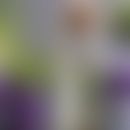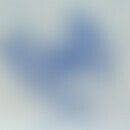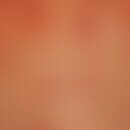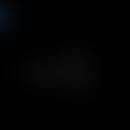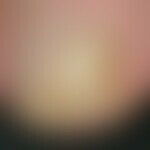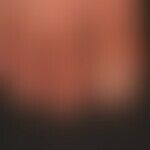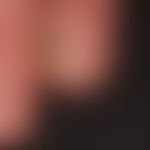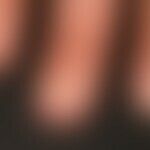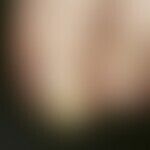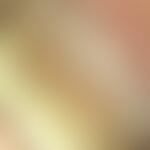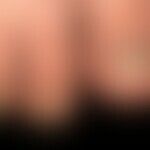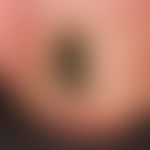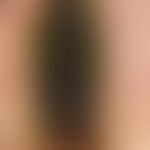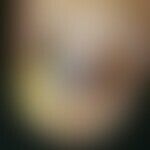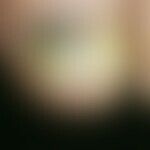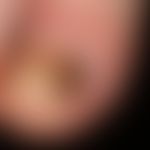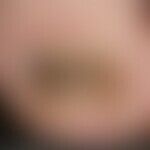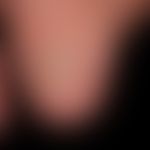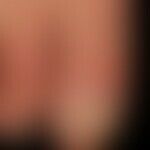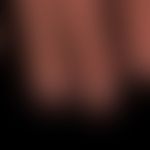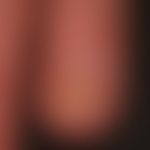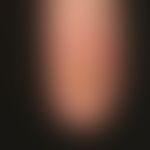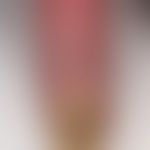Synonym(s)
HistoryThis section has been translated automatically.
DefinitionThis section has been translated automatically.
Mostly chronic infection of the nail organ with fungi, especially dermatophytes, but also "nondermatophyte moulds" - NDM - such as Scopulariopsis brevicaulis, Fusarium species and rare molds.
See further below for mycoses.
You might also be interested in
PathogenThis section has been translated automatically.
Most frequently (80%) infestation by dermatophytes (Tinea unguium):
- Trichophyton rubrum
- Trichophyton mentagrophytes
- Epidermophyton floccosum.
- Yeasts do not possess their own keratinases, therefore cannot infect an intact nail. They are found either in mixed infections in mycotic paronychia or saprophytically in the cleft space under the nail in mycotic onycholysis. Yeasts are most commonly isolated from fingernails.
- Molds can be isolated virtually only from toenails. The role as a primary pathogen for most molds is controversial, but for certain species (e.g., Aspergillus fumigatus, Aspergillus flavus, Scopulariopsis brevicaulis, Fusarium spp., Neoscytalidium dimidiatum) are recognized.
Note: Infections of the nail matrix with yeasts and/or molds are by definition referred to as "onychomycosis" rather than tinea unguium. Mixed infections with dermatophytes, molds and yeasts are possible.
ClassificationThis section has been translated automatically.
A distinction is made between:
- DSO (distal subungual onychomycosis)
- PSO (proximal subungual onychomycosis)
- WOO (white superficial onychomycosis)
- Onychomycosis due to moulds
- Paronychia candidamycetica
- Total dystrophic onychomycosis
- Mycotic onycholysis.
Occurrence/EpidemiologyThis section has been translated automatically.
EtiopathogenesisThis section has been translated automatically.
LocalizationThis section has been translated automatically.
Clinical featuresThis section has been translated automatically.
The course of onychomycosis is usually slow and chronic, often coming to a standstill for years. It is unclear why some nails are affected and others are free. 6 types can be distinguished:
- Distal subungual onychomycosis (DSO): The infection, whose causative agent often originates from a pre-existing tinea pedum with interdigital infestation, occurs through the hyponychium and the distal portion of the lateral nail sulcus and slowly penetrates the nail bed to the matrix. The covering nail plate often becomes opaque, discolored, and brittle due to secondary infestation. Eventually, nail growth disturbance occurs. The entire nail organ may be affected. DSOM is the most common manifestation of tinea unguium.
- White superficial onychomycosis (WOO): Also known as Leukonychia trichophytica or Leuconychia mycotica (Jessner). Occurs almost exclusively on the toenails and is caused in over 90% by Trichophyton mentagrophytes. This form is based on a pre-damage of the nail plate, which is colonized by keratinophilic fungi. Due to the strength of the keratin, only superficial colonisation takes place, penetration into the depth is low. In the early stages, the affected areas appear as small white spots or plaques. As the disease progresses, whitish, sometimes flat stripes form in the nail matrix. The nail bed is not affected.
- Proximal subungual type (PSO): Overall quite rare. Probably originating from an infection of the skin of the proximal nail wall, which may extend to the cuticle. The pathogens cross the skin barrier between the nail surface and cuticle and spread distally to the matrix via the cuticle along the eponychium. A patchy discoloration of the nail plate over the lunula and in the nail bed is typical. Extensive onycholysis may occur relatively suddenly. Rarest form of onychomycosis.
- Total dystrophic onychomycosis: On the one hand observed in chronic mucocutaneous candidiasis, on the other hand also as final stage of distal as well as proximal subungual onychomycosis. In this case, friable nail plate remnants are found, mostly of a papillomatous nail bed with pronounced hyperkeratosis.
- Paronychia candidamycetica (Candida paronychia with concomitant nail changes): this is caused either by chronic mucocutaneous candidiasis (in the course of untreated onychomycosis this usually leads to complete destruction of the nail plate) or chronic recurrent paronychia (fungi migrate from the inflamed nail wall). Infestation of the nail matrix can occur distally subungual, laterally, distolaterally as well as proximally subungual.
- Mycotic onycholysis: Occurs almost exclusively on the fingernails. Almost always caused by Candida albicans and other Candida species. After injury to the hyponychium, detachment of the nail plate from the nail bed occurs if the patient is predisposed to it and under appropriate workplace conditions. The invasion of yeasts is hereby promoted. An additional bacterial colonization is almost always present. Often, a grey-yellowish, paste-like, not infrequently foul-smelling mass can be scraped out from under the nail. Superinfections with Pseudomonas aeruginosa or protein species lead to an additional blackish-green to black colour.
DiagnosisThis section has been translated automatically.
Professional mycological examination with correct material collection (prior disinfection with 70% alcohol: as far as possible proximal sampling by means of curettage technique), presentation of the fungi in the native preparation, identification of the pathogen in the fungal culture. Histological examination of the nail material may be necessary (PAS presentation). For the diagnosis of an onychomycosis caused by moulds, a 3-fold consecutive cultural isolation of the same mould species and the missing detection of a dermatophyte is necessary.
In addition, there is the possibility of diagnostics by means of the polymerase chain reaction (PCR). This method impresses with its high sensitivity and speed of diagnosis.
Differential diagnosisThis section has been translated automatically.
TherapyThis section has been translated automatically.
The aim of antimycotic therapy is the complete healing of the mycotic nail infection! This requires external treatment, if necessary in combination with the systemic therapy with simultaneous sanitation of shoes and stockings.
- With regard to the success of the systemic therapy for Tinea unguium, it can be seen that, even with modern antimycotics, this goal is only achieved in about 50% (!) of patients. Follow-up examinations 1-3 years after completed treatment show recurrence rates between 5% and 20% after therapy with modern antimycotics, after Grisefulvin treatment even 40%. Reasons for this are lack of compliance, dormant arthrospores in cavities of the hyperkeratotic nail organ (so-called glacial nail), which cannot be attacked by antimycotics, immunological disorders, peripheral circulatory disorders, slowed nail growth (e.g. in elderly patients).
- Simultaneously to the system therapy, the atraumatic removal of the diseased nail plate is recommended. This significantly increases the therapeutic effects.
- In case of very slow growth of the nail (age, AVK), the indication for system therapy should be made strictly, as the healing prospects are significantly lower.
General therapyThis section has been translated automatically.
Improve circulation conditions, do not wear constricting footwear, air-impermeable shoes and/or stockings, disinfect stockings and footwear, avoid moisture, dry hands and feet thoroughly, change clothes frequently, boil socks at 95 °C if possible or use laundry disinfectant. Advise patients of the lengthy treatment, which can take several months.
External therapyThis section has been translated automatically.
Localized infestation (distal onychomycosis, < 50% of the nail plate affected):
- Roughen nail plate (disposable nail files!) and local therapy with modern broad-spectrum antifungals (azole antifungals) such as 1% bifonazole, 8% ciclopirox (Batrafen®nail polish) or 5% amorolfine (Loceryl nail polish). Apply solution or cream 1-2 times/day, apply nail varnish (Loceryl, Batrafen) 1-2 times/week to the affected nail. Apply nail Batrafen in a thin layer on the affected nail every 2nd day in the first month, at least 2 times/week in the second month of treatment, 1 time/week from the 3rd month of treatment. Therapy duration in total over several months.
- A water-soluble varnish - Ciclopoli® nail polish, penetrates deeply into and under the nail plate. As a water-soluble varnish, it must be applied daily, no roughening of the nail plate is required.
Extensive infestation:
- First remove affected nail areas by chemical onycholysis, e.g. with bifonazole/urea combination (Canesten extra Nagelset or Mycospor Nagelset), urea nail softening paste (e.g. Onychomal cream, urea paste 40% with clotrimazole 1%, urea , urea paste -after Farber) or potassium iodide nail softening paste, (e.g. R141 ) and then continue as above. Alternatively, plasters containing salicylic acid (Guttaplast). Professional sanitation of the nail plate has the advantage of reducing the fungal mass and improving the penetration of external antifungal agents.
Alternative: The alternative of the chemical one is the mechanical nail sanitation by means of a high-speed cutter by a podiatrist.
Notice. Therapy with externally acting antimycotics is usually successful in localized infestation (< 50% of the nail surface) without matrix infestation! In case of matrix infestation, systemic therapy should be considered (combination therapy achieves higher cure rates and reduces systemic exposure to drugs). External, continuing, prophylactic therapy is also indicated in patients who are clinically free of symptoms after oral therapy.
Alternative (or complementary) laser therapy:
- For therapy-resistant onychomycosis: Various types of lasers are currently in clinical use. Well studied for this indication are the Nd:YAG lasers (neodymium YAG laser). Several systems of this laser type are available, which differ technically:
- Long pulsed lasers (e.g. Dualis), short pulsed lasers (e.g. Pinpoint, FootLaser, GenesisPlus, Varia, Cooltouch, Cool Breeze).
- Furthermore applicable: Nd-Yttrium-Laser (e.g. 3step-Laser), the 980 nm diode laser (QuadroStarPRO), ablative lasers like Erbium-YAG-Laser and CO2-Laser, as well as flash lamps.
- Note: The experience with laser systems for monotherapy of advanced onychomycosis is reported as "cautiously positive". According to our own experience, laser therapy alone is rarely successful. Therefore, laser therapies of advanced and therapy-resistant onychomycosis are to be evaluated as part of a multimodal therapy concept with medical podiatry, antifungal topical and systemic treatments.
Internal therapyThis section has been translated automatically.
Indication for oral monotherapy:
- DSO (distal lateral subungual onychomycosis) with > 50% infestation of the nail plate or nail matrix.
- DSO on > 2 nails
- PSO (proximal subungual onychomycosis)
- WOO (white superficial onychomycosis, Leukonychia trichophytica)
- Patients showing no response after 6 months of (efficient) topical monotherapy.
Itraconazole: Interval therapy with itraconazole (e.g., Sempera 7®): 400 mg/day for 7 days followed by a 3-week break in therapy. In case of infection of the fingernails alone, this regimen usually has to be repeated 2 times and in case of toenail mycoses 3 times. Itraconazole is effective for infections with dermatophytes, yeasts as well as moulds. Itraconazole should only be prescribed for a maximum of 3 months due to potential toxic effects (connection between itraconazole and hypertrophic heart disease is suspected). According to guidelines and package inserts, itraconazole is not recommended in children, but it is used today.
SUBA-itraconazole: Galenical further development of itraconazole: by incorporating a polymer (so-called "super bioavailability" technology - SUBA, the increase in stability, bioavailability and absorption of the active ingredient has been improved with the possibility of lowering the dose: in the case of SUBA-itraconazole (Itraisdin®50 mg ), 50 mg corresponds to the conventional itraconaz0l 100 mg. In the literature, the minimum dosed therapy is given as follows: 1 capsule of 50 mg daily for 7 days, then one capsule per week until complete cure. Caution: currently this dosage is an off-label therapy! In the package insert with 2 capsules Itraisdin over 12 weeks.
- Alternative for dermatophyte infections: Terbinafine (1 time/day 250 mg p.o.); according to the currently valid guidelines and package insert: therapy duration 3-4 months, for big toe infestation up to 6 months. Nevertheless, modern internal therapy is nowadays carried out with only one dose per week after a 7-day saturation period, although this represents an off-label use. In the meantime, there are even shorter regimens: after a 3-day saturation period, 1 tablet of Terbinafine 250 mg per week is given. Interval therapies are also successful with Terbinafine (4 weeks therapy/4 weeks therapy break; 3-4 cycles; alternatively pulse therapy: 250 mg/day over 7 days = 1 treatment cycle; multiple repetition after 3 months). Cave! also this dosing regimen represents an off-label-use - the completion of the new guidelines are planned until the end of the year 2021. Terbinafine therapy in children is not recommended in the guidelines or in the package insert, but is certainly used today. For tinea capitis, however, a curative trial with terbinafine curative trial according to the AMG is stated in the S 1 guideline. The dose for Terbinafine in children is: <20kg: 62,5mg/day; 20-40kg: 125mg/day; 40kg: 250mg/day.
- Alternative: Fluconazole (Diflucan Derm ®) 1 time/week 150 or 300 mg p.o. until cure (usually 6 monthsfor fingernails and 12 months for toenails). The dose in children is 3-6mg/kg bw 1x weekly for 12 weeks for fingernails and 26 weeks for toenails. Fluconazole inhibits cytochrome P450 enzymes.
- Combination therapy for severe onychomycosis: amorolfine 1-2 times/week for 6-15 months and terbinafine 250 mg for 6-12 weeks or itraconazole 200 mg 1 time/day for 6-12 weeks.
- Griseofulvin (e.g., Likuden®) micronized or ultramicronized 500 mg up to 1000 mg/day p.o. in 2 ED after meals; continuous therapy until all toenails have regrown healthily. Duration of therapy: 6-12 months and more. Note: In Germany, ready-to-use preparations with griseofulvin are not available!
- Posaconazole (e.g. Noxafil) Indicated only for refractory invasive fungal infections (IFI) / patients with IFI and intolerance to first-line therapy.
Reinfection and recurrence (up to 25% of patients): Apart from application errors, local (lateral infestation, marked onycholysis, massive hyperkeratosis, involvement of the lunulae) or systemic (immunosuppression, diabetes mellitus, acral circulatory disorders, low regrowth, old age) factors may be causative. The following therapeutic modalities are recommended:
- Sequential pulse therapy (Itraconazole/Terbinafine): 2 pulse therapies with Itraconazole (400mg/day p.o. for 7 days 1x/month); followed by 2 pulse therapies with Terbinafine (500mg/day p.o.for 7 days 1x/month).
- Combination of pulse therapy with mechanical or chemical onycholysis, e.g. with bifonazole/urea combination (Canesten extra nail set or Mycospor nail set).
NaturopathyThis section has been translated automatically.
Good results are reported from the application of tea tree oil 2-3 times / day. S.a.u. Tea tree oil. For the feet, regular foot baths in dead sea salt are suitable. Bathing with the addition of lavender oil, see Lavandulae aetheroleum, has also proven successful due to the disinfecting effect of lavender.
Note(s)This section has been translated automatically.
- For the reliable differentiation of Trichophyton rubrum and Trichophyton interdigitale, special culture media (e.g. potato glucose agar or urea agar) may additionally be required for the detection of urea cleavage of Trichophyton interdigitale.
- The consistent cooperation of the patient is a prerequisite for external treatment. Unfortunately, there are limits to this in cases of obesity and age-related immobility of the patient.
- OM caused by mould fungi do not respond to systemic antimycotic therapy. An exception is Aspergillus sp. where Terbinafine is effective in individual cases.
Billing tips:
- Taking: The smear test is to be taken according to No. 298 GOÄ (also several times, in case of different smears). Body parts and separate preparation). In the case of complex nail removal, the No. 743 GOÄ (analogous) can be applied.
- Microscopy: In case of microscopic fungus detection with addition of potassium hydroxide solution, No. 4711 GOÄ can be used. Simple staining with methylene blue is accounted for with No. 3509 GOÄ (per preparation).
- Culture: A Sabouraud agar (simple culture medium) is charged with No. 4715 GOÄ up to 5 times from the same medium. If special culture media (complex culture medium) are used, the number 4716 GOÄ or the No. 4717 (differentiation medium) must be used.
- Light microscopic examination of cultivated fungi: No. 4722 GOÄ.
LiteratureThis section has been translated automatically.
- Angerstein JH (1987) How tea tree oils heal. With formulations against the most common complaints. Midens Verlag, Augsburg
- Ahmad SR et al (2001) Congestive heart failure associated with itraconazole. Lancet 357: 176-177
- Baran R (2001) Topical amorolfine for 15 months combined with 12 weeks of oral terbinafine, a cost-effective treatment for onychomycosis. Br J Dermatol 145 Suppl 60: 15-19
- Crawford F et al (2002) Oral treatments for toenail onychomycosis: a systematic review. Arch Dermatol 138: 811-816
- Evans EGV et al (1999) Double blind, randomised study comparing continous terbinafine with intermittend itraconazole in the treatment of toenail onychomycosis. Br Med J 318: 1031-1035
- Gupta AK (2003) Non-dermatophyte onychomycosis. Dermatol Clin 21: 257-268
- Gupta AK et al (2002) Onychomycosis: strategies to improve efficacy and reduce recurrence. J Eur Acad Dermatol Venereol 16: 579-586
- Hantschke D (1996) Diagnosis and therapy of onychomycosis. Akt Dermatol 22: 132-136
- Iorizzo M et al (2010) Current treatment options for onychomycosis. JDDG 8: 875-880
- Lecha M et al (2001) Amorolfine and itraconazole combination for severe toenail onychomycosis; results of an open randomized trial in Spain. Br J Dermatol 145 Suppl 60: 21-26
- Update on current approaches to diagnosis and treatment of onychomycosis.
Gupta AK et al (2018) Expert Rev Anti Infect Ther. 2018 Dec;16(12):929-938. doi: 10.1080/14787210.2018.1544891. epub 2018 Nov 13.
- Larsen GK et al (2003) The prevalence of onychomycosis in patients with psoriasis and other skin diseases. Acta Derm Venereol 83: 206-209
- Linares MJ et al (2005) Susceptibility of filamentous fungi to voriconazole tested by two microdilution methods. J Clin Microbiol 43: 250-253
- Roberts DT et al (2003) Guidelines for treatment of onychomycosis. Br J Dermatol 148: 402-410
- Seebacher C et al (2007) Onychomycosis. J Dtsch Dermatol Ges 5: 61-66
- Seebacher C (1998) Limitations of short-term treatment of onychomycosis. Dermatologist 49: 705-708
- Seebacher C et al (2007) Tinea of the free skin. J Dtsch Dermatol Ges 11: 921-926
- Shemer A et al. (2007) Nail sampling in onychomycosis: comparative study with curettage at three sites of the infected nail.JAAD 5:1108-1111.
- Solís-Arias MP et al (2017) Onychomycosis in children. A review.
Int J Dermatol 56:123-130. - Ständer H et al (2001) Incidence of fungal involvement in nail psoriasis. Dermatologist 52: 418-422
- Tosti A et al (2003) Management of onychomycosis in children. Dermatol Clin 21: 507-509
- Virchow R (1854) On the normal and pathological anatomy of the nails and epidermis. Verhandl Physikal Med Gesellsch Würzburg 5: 83-105
- Gupta AK et al (2018) Update on current approaches to diagnosis and treatment of onychomycosis. Expert Rev Anti Infect Ther 16:929-938
- Ahmad Y et al. (2015): Population Pharmacokinetic Modeling of Itraconazole and Hydroxyitraconazole for Oral SUBA-Itraconazole and Sporanox Capsule Formulations in Healthy Subjects in Fed and Fasted States. Antimicrob Agents Chemother 59: 5681-5696.
- AMWF guidelines: https://dmykg.ementals.de/wp-content/uploads/2015/08/Onychomycosis.pdf.
- Tietz HJ (2017): Onychomycosis in adults and children. Successful therapy in daily practice. The General Practitioner 39: 42-47.
- Tietz H-J (2017): Mycoses of the skin. New pathogens and advances in therapy. MMW 236: 50-55
Incoming links (49)
Age nail; Amorolfin; Anonychie acquired; Bifonazole; Candida guilliermondii; Candida onychomycosis; Chromonychia; Ciclopirox; Dermatophytosis syndrome; Epidermophyton floccosum; ... Show allOutgoing links (42)
Acrodermatitis continua suppurativa; Acute paronychia; Amorolfin; Antimycotics; Arterial occlusive disease peripheral; Aspergillus flavus; Aspergillus fumigatus; Bifonazole; Candida; Candida paronychia; ... Show allDisclaimer
Please ask your physician for a reliable diagnosis. This website is only meant as a reference.
